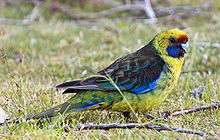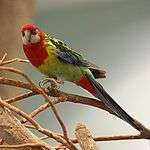Rosella
| Rosella | |
|---|---|
 | |
| Adult crimson rosella | |
| Scientific classification | |
| Kingdom: | Animalia |
| Phylum: | Chordata |
| Class: | Aves |
| Order: | Psittaciformes |
| Superfamily: | Psittacoidea |
| Family: | Psittaculidae |
| Subfamily: | Platycercinae |
| Tribe: | Platycercini |
| Genus: | Platycercus Vigors, 1825 |
| Species | |
A rosella is one of six species of colourful Australian parrots in the genus Platycercus. Platycercus means "broad-tailed" or "flat-tailed", reflecting a feature common to the rosellas and other members of the broad-tailed parrot tribe. Their diet is mainly seeds and fruit.
Etymology
Early European settlers encountered the eastern rosella at Rose Hill, New South Wales, now Parramatta, and so they called it the Rosehill parakeet which became "Rosehiller", and eventually "rosella".[1]
Description
Ranging in size from 26–37 cm (10–14.5 in), rosellas are medium-sized parrots with long tails.[2][2] The feathers on their backs show an obvious scalloping appearance with colouring that differs between the species.[2] All species have distinctive cheek patches.[2] Sexual dimorphism is absent or slight – males and females generally have similar plumage, apart from the western rosella.[3] The juveniles of the blue-cheeked species, and western rosella, all have a distinctive green-based plumage, while immature plumage of the white-cheeked species is merely a duller version of the adults.[3]
Distribution and habitat
Rosellas are native to Australia and nearby islands, where they inhabit forests, woodlands, farmlands, and suburban parks and gardens. They are confined to the coastal mountains and plains and are absent from the outback. Introduced populations have also established themselves in New Zealand (notably in the North Island and in north Dunedin) and on Norfolk Island.
Behaviour and ecology
Rosellas feed predominantly on seeds and fruit, with food held in the foot. They enjoy bathing in puddles of water in the wild and in captivity.[4] Rosellas scratch their heads with the foot behind the wing.[4]
Mutual preening is not exhibited by the genus, and the courtship display is simple; the male waves his tail sideways, and engages in some head bobbing, and the female reciprocates.[3]
Like most parrots, they are cavity nesters, generally nesting high in older large trees in forested areas. They generally have a clutch size of several eggs which are incubated for around 21 days by the female alone. The male feeds the female through this time and for some time after incubation concludes. Quickly covered in a white down, chicks take around five weeks to fledge.[3]
Aviculture
The more colourful rosella species are popular as pet parrots and also as aviary birds. They can live for longer than 20 years, and they are relatively easy to breed.[5] All have a reputation for being aggressive in captivity, and are hence recommended be kept separate from other caged birds. Their diet in aviculture includes seeds, fruit such as apple, pear, and grapes, and vegetable matter such as lettuce, grass, and silver beet.[4]
Taxonomy

The genus was described by naturalist Nicholas Aylward Vigors in 1825; the name Platycercus derived from the Ancient Greek "broad-" or "flat-tailed". The relationships with other parrots have been unclear, with the Australian Ringneck cited as a closest relative by some, and the genus Psephotus by others; the plumage of the western rosella seen as a link to the latter genus.[3]
There are, broadly speaking, three groups of rosella species. They are the blue-cheeked species which includes elegans and caledonicus, the white-cheeked species, eximius, adscitus and venustus and the yellow-cheeked species, icterotis. The observed difference in plumage has been reinforced by molecular studies in 1987 and 2015 that place the icterotis as a basal offshoot.[6]
There are six species and several subspecies:[7] Ovenden and colleagues analysed mitochondrial DNA, confirming the blue-cheeked and white-cheeked lineages. They found P. caledonicus to be basal to the other blue-cheeked forms, with P. elegans nigrescens being divergent from other subspecies of P. elegans. Also, P. venustus was basal to P. eximius and P. adscitus.[6] In 2015, Ashlee Shipham and colleagues published a molecular study based on nuclear DNA finding that P. venustus and P. adscitus were sister species, and that P. elegans nigrescens diverged earlier than P. caledonicus.[8]
Platycercus, Vigors 1825
- Platycercus caledonicus, (Gmelin 1788)
- Platycercus caledonicus brownii, (Kuhl 1820)
- Platycercus caledonicus caledonicus, (Gmelin 1788)
- Platycercus elegans, (Gmelin 1788)
- Platycercus elegans elegans, (Gmelin 1788)
- Platycercus elegans flaveolus, Gould 1837
- Platycercus elegans fleurieuensis, Ashby 1917
- Platycercus elegans melanopterus, North 1906
- Platycercus elegans nigrescens, Ramsay, EP 1888
- Platycercus elegans subadelaidae, Mathews 1912
- Platycercus venustus, (Kuhl 1820)
- Platycercus venustus hilli, Mathews 1910
- Platycercus venustus venustus, (Kuhl 1820)
- Platycercus adscitus, (Latham 1790)
- Platycercus adscitus adscitus, (Latham 1790)
- Platycercus adscitus palliceps, Lear 1832
- Platycercus eximius, (Shaw 1792)
- Platycercus eximius diemenensis, North 1911
- Platycercus eximius elecica, Schodde & Short 1989
- Platycercus eximius eximius, (Shaw 1792)
- Platycercus icterotis, (Temminck & Kuhl 1820)
- Platycercus icterotis icterotis, (Temminck & Kuhl 1820)
- Platycercus icterotis xanthogenys, Salvadori 1891
| Species | |||
|---|---|---|---|
| Common and binomial names | Photograph | Description | Range |
| Western rosella (Platycercus icterotis) |
-5-4c.jpg) |
26 cm (10 in) long, the smallest rosella. The male is mainly red with yellow cheek patches, green rump, and a dark green tail. The female is duller, with a mainly green head, reddish forehead, yellow cheeks, and variegated green-red underparts. Colours of scalloped back feathers differ between two subspecies. The bill is whitish and the irises are dark brown.[9] | Southwest Australia |
| Crimson rosella (Platycercus elegans) |
 |
36 cm long, five subspecies, three of which are actually crimson. The red is replaced by yellow in the case of var. flaveolus and a mixture of red, orange and yellow in the Adelaide rosella. | East and Southeast Australia |
| Green rosella (Platycercus caledonicus) |
 |
37 cm (15 in) long, the largest rosella. It has a yellow head and underparts with blue cheeks and a red frontal band above the bill. The feathers on the back and inner wings are black with narrow green margins at their tips, and the outer wing feathers are blue and green. Rump olive and the tail green. Irises are dark brown and the bill is light grey.[2] | Tasmania |
| Pale-headed rosella (Platycercus adscitus) |
30 cm long, mostly covered in blue except for the upper breast and head which are cream-yellow, the tail is blue-black and green, and an area around the vent is red. Two subspecies. | Eastern Australia | |
| Eastern rosella (Platycercus eximius) |
 |
30 cm (12 in) long. Red head and white cheeks. The upper breast is red and the lower breast is yellow fading to pale green over the abdomen. The feathers of the back and shoulders are black, and have yellowish or greenish margins giving rise to a scalloped appearance that varies slightly between three subspecies and the sexes. The wings and lateral tail feathers are bluish while the tail is dark green.[9] | Australia and Tasmania. Introduced to New Zealand where feral populations are found in most of North Island and the hills around Dunedin in the South Island[10] |
| Northern rosella (Platycercus venustus) |
 |
28 cm long, forehead, crown and nape are black in colour with white-on-blue cheek-patches. The back and wing feathers are blackish with yellow borders, while the feathers of the belly, chest and rump are pale yellow with black borders giving rise to a scalloped appearance, tail is bluish green. The bill is pale grey. | The northern rosella is found from the Gulf of Carpentaria, through Arnhem Land to the Kimberleys in open savannah country, Australia. |
References
- ↑ Stepnell, Kenneth; Boles, Walter. Australia's beautiful birds and their young. Sydney, Australia: Australian Consolidated Press. p. 88. ISBN 0-949892-13-0.
- 1 2 3 4 5 Forshaw (2006). plate 53.
- 1 2 3 4 5 Lendon, p. 169
- 1 2 3 Lendon, p. 170
- ↑ Alderton, David (2003). The Ultimate Encyclopedia of Caged and Aviary Birds. London, England: Hermes House. p. 185. ISBN 1-84309-164-X.
- 1 2 Ovenden JR, Mackinlay AG, Crozie RH (1987): Systematics and Mitochondrial Genome Evolution of Australian rosellas (Aves: Platycercidae). Molecular Biology and Evolution 4(5): 526–543. PDF fulltext
- ↑ "Zoological Nomenclature Resource: Psittaciformes (Version 9.024)". www.zoonomen.net. 2009-05-30.
- ↑ Shipham A, Schmidt D, Joseph L, Hughes J (2015). "Phylogenetic analysis of the Australian rosella parrots (Platycercus) reveals discordance among molecules and plumage". Molecular Phylogenetics and Evolution. doi:10.1016/j.ympev.2015.05.012.
- 1 2 Forshaw (2006). plate 56.
- ↑ Wright D, Clout M (2001): The eastern rosella (Platycercus eximius) in New Zealand. DOC Science Internal Series 18. Department of Conservation, Wellington. 27 p (out of print) PDF fulltext
| Wikimedia Commons has media related to Platycercus. |
Cited texts
- Forshaw, Joseph M. (2006). Parrots of the World; an Identification Guide. Illustrated by Frank Knight. Princeton University Press. ISBN 0-691-09251-6.
- Lendon, Alan H. (1973). Australian Parrots in Field and Aviary (2nd. ed). Sydney: Angus and Robertson. ISBN 0-207-12424-8.